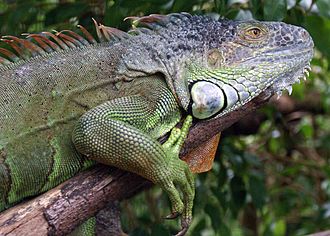Type the name of the breed you're looking for below
[wpdreams_ajaxsearchlite] Don't see the breed your're looking for? Click here and let us know!
Green Iguana
| Place of Origin and Range | The native range of the Green Iguana extends from southern Mexico to central Brazil, Dominican Republic, Paraguay, and Bolivia and the Caribbean; specifically Grenada, Curaçao, Trinidad and Tobago, St. Lucia, St. Vincent, and Útila. They have been introduced to Grand Cayman, Puerto Rico, Texas, Florida, Hawaii, and the United States Virgin Islands. |
| Description | Green iguanas have very sharp teeth that are capable of shredding leaves and even human skin. These teeth are shaped like a leaf, broad and flat, with serrations on the edge. As in all iguanas, the tail comprises much of this length, and the snout-to-vent length of most green iguanas is 30 to 42 cm (12 to 17 in). They are light green with predominant black stripes, or a typical orange dewlap, the iguanas of St. Lucia have a black dewlap. |
| Morph Patterns Available | Yes |
| Adult Size | Can grow 6+ feet (1.9 m) |
| Accommodation | Green iguanas will thrive only in temperatures of 79 °F (26 °C) to 95 °F (35 °C) and must have appropriate sources of UVB and UVA lighting, or else their bodies cannot produce vitamin D that promotes calcium absorption, which can result in a metabolic bone disease that can be fatal. A large enclosure and access to fresh water. 6 f x 6 f x 30 inches. |
| Lifespan | Can live 15 - 20 years |
| Feeding / Diet | Green Iguanas are primarily herbivores, with captives feeding on leaves such a turnip greens, mustard greens, dandelion greens, flowers, fruit, and growing shoots of upwards of 100 different species of plant. There is evidence of wild iguanas eating grasshoppers and tree snails, usually as a by-product of eating plant material. A captive Green Iguana's diet should consist of fresh leafy vegetables such as mustard greens, collard greens, dandelion, arugula, or kale and access to fresh water. |
| Breeding | Green iguanas are oviparous with females laying clutches of 20 to 71 eggs once per year during a synchronized nesting period. The female green iguana gives no parental protection after egg laying, apart from defending the nesting burrow during excavation. |



